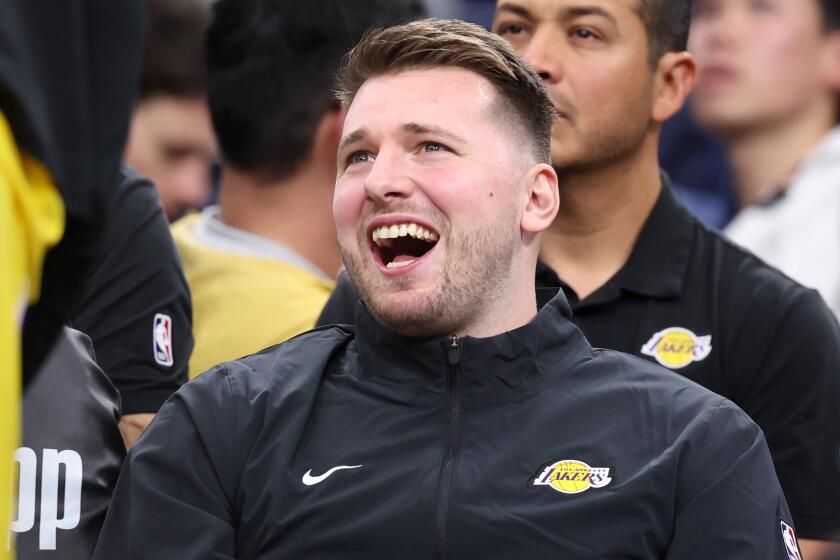Youth Sports Shouldn’t Be About Winning
- Share via
It starts out so pure. Parents sign their kids up for soccer, basketball or other sports for all the right reasons--to help them get fit, learn new skills, build character and have fun. With childhood obesity rates skyrocketing and physical education classes being slashed by budget-crunched schools, organized sports play an increasingly important role in getting today’s kids moving.
Yet all too often, when the whistle blows and the game begins, a strange phenomenon occurs.
“People start to think, ‘If you’re not a winner, you’re a loser,’ ” says Kevin Daugherty, youth sports specialist for the American Sport Education Program, a Champaign, Ill.-based group that provides resources for coaches and parents. And that’s when destructive behavior starts.
Horror stories abound of “trash talking,” fighting and other forms of disrespect toward opponents, officials and even teammates. And sadly enough, the offenders are often the parents.
“Our culture bombards us with messages that winning is everything,” Daugherty says. “But many people don’t seem to realize that youth sports are different from professional sports. Pro sports are about winning games and making money. Youth sports are about having fun, improving skills, developing character and learning to make a lifetime commitment to physical activity.”
Kids who feel pressured to win are at risk for dropping out, says David McCann, a school sports specialist with the sport education program.
“The two main reasons kids play sports is to have fun and to be with their friends,” he says. “Winning is way down on their list.”
Most kids would rather be active participants on a losing team, he says, than sit on the bench of a winning one.
Overemphasis on competition is central to why an estimated 4% to 5% of the 25 million American kids involved in organized sports drop out each year, says Marty Ewing of the Institute for the Study of Youth Sports at Michigan State University.
This dropout rate jumps to 10% to 14% when kids hit middle school, an age she calls “the most critical time in a child’s life” to encourage activity. Precisely when adolescents need the physical and mental benefits of sports participation, they are at the greatest risk of quitting and becoming sedentary.
“Community programs exist for kids [of grade-school age], but opportunities diminish in middle school,” Ewing says. “If kids don’t make their school team, they often don’t have other options.”
At this age, too, middle schoolers complain that sports “become too serious and stop being fun,” she says. “Girls say coaches put them under too much pressure; boys complain that coaches play favorites. And kids who aren’t very good feel discouraged from playing at all.”
Girls are at greater risk for becoming sedentary than boys are, with some research suggesting that even at the grade school level, girls are less active than boys. For example, a study of more than 700 elementary-school children in Minnesota revealed striking gender differences in playground behavior.
“Boys gravitate toward ballgames that involve such basic motor skills as kicking, catching and throwing and that tend to involve set rules for play,” report researchers from the Melpomene Institute for Women’s Health Research in St. Paul. “In contrast, girls gravitate toward more social play, shadowing teachers, playing in small groups on the swings or sitting and talking.”
By adolescence, kids tend to become even less active, in part because of competing demands on teenagers’ time--from homework and jobs to surfing the Internet and playing video games. Participation in physical activity continues to decline throughout high school and “plummets” in college, says Howell Wechsler, physical activity specialist at the Centers for Disease Control and Prevention in Atlanta.
“We’re no longer a society where kids go running around the neighborhood,” he says. “They’ve got computers and 98 TV channels and parents who are worried that they might be kidnapped.” That’s why, Howell says, “we’ve got to make physical activity appealing so kids will want to participate and make it a lifetime habit.”
Experts offer this advice for parents who want to “jump start” inactive kids:
* Expose your child to a variety of activities, and let him or her decide what to play.
* Be a good role model. Be active yourself, do active things as a family and be a good sport.
* Applaud effort. Don’t give false praise, but always try to find something to compliment. (“Good swing,” “nice try,” “way to hustle.”)
* Listen. Especially after a disappointment, give your child a chance to express feelings in an atmosphere of unconditional love and support.
* Set limits on sedentary activity.
* Don’t just ask, “Did you win?” Instead, ask questions geared to the sport experience, such as: “What was the best part of the practice / game?” or “Can I help you improve any skill?” And, most important, “Did you have fun?”
*
Resources:
* The American Sport Education Program offers a variety of material for parents and coaches, including a 16-page SportParent Survival Guide. Call (800) 747-5698.
* The Melpomene Institute offers two brochures, “Fit Kids” (free) and “Girls, Self-Esteem and Sports” ($1). Send a self-addressed, stamped envelope to Melpomene, 1010 University Ave., St. Paul, MN 55104.
More to Read
Go beyond the scoreboard
Get the latest on L.A.'s teams in the daily Sports Report newsletter.
You may occasionally receive promotional content from the Los Angeles Times.










